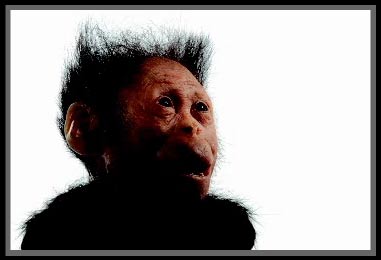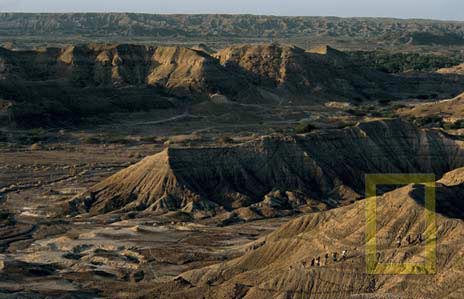Child 3 million years old
Ethiopian archaeologists found the remains of a 3-year-old girl called Dikika. She lived and died in the early days of human formation on earth. This girl's remains contain many clues related to ancestors, the origin of humanity.
Zeresenay Alemseged, an archaeologist who specializes in the evolutionary history of mankind, boasts that he has two children: a son he himself was born with and being cared for in his mother's arms at the warm wooden house offering in Addis Ababa, Ethiopia's capital. The other was a little girl on three Dikika, a child who spent 3.3 million years covered in sandstone that he and his team discovered in the Awash River of Rift Valley, a remote area of Ethiopia. This event was very valuable for an archaeologist like him, so he saw Dikika as his second son. As for Dikika, she looked like she was born a second time.

Baby girl on three Dikika lived 3 million years ago to recreate from studying skulls and remains (Photo: Nationalgeographic)
So far, all fossils of this ancient child can be wrapped in a newborn baby's diaper . These new remains not only help scientists get the nearly complete skeleton of children in the primitive period, but it is also thought that these are the best bones of the primitive human ape. There was also a similar fossil of a woman who was 3.2 million years old (people called her Lucy) found in 1974. Like Lucy, Dikika has fingers and feet. , and my body is complete. But the quite impressive difference between these two varieties is that Dikika has a more complete face.

The vast arid region of Ethiopia makes the search group small in front of nature.(Photo: Nationalgeographic)
Although tiny, the bone pack contains evidence to prove the evolutionary steps of humanity. As we and our ancestors used to know: the early age began from a long time ago, human evolution is based on the development of the brain, the first sign is the large size change. gradually. Beyond that perfection, the important thing of this discovery is thinking, it will explain how the primitive humanity can live, mature and evolve in a body structure. very simple.

The skull and bones of Dikika were found in Ethiopia.
(Photo: Nationalgeographic)
There is a coincidental coincidence that unfortunate babies who were lost during the breastfeeding period had the same name , Dikika , in the remote dialect of Ethiopia, meaning the nipple. The area where Dikika was discovered was a land of terrible droughts, brutal flash floods, in addition to malaria, and fights between opposing groups. Of course, the competition of wild animals like lions, hyenas or uninvited guests who specialize in other nightlife is excluded. On Earth, this is the most difficult place to find fossils and is the place with the most fertility rates in the world.
Several decades ago, this area was a low, very low area compared to the sea and owned by foreigners, they were leaders in expeditions to find the promised land. Until Zeresenay led a group looking for fossils to set foot in this remote barren land in 1999. It was not until December 2000 that Zeresenay's archaeological group found only fossil samples of the mammals such as elephants, hippos, rhinos . absolutely no trace of humans. But it was not that Zeresenay was discouraged, he knew he was in the right place. The problem is just time and a little luck. From the fossil animal samples he found, he said that if there were many animals that grew in the old forest next to the ancient Awash river, it would inevitably have the life of prehistoric people, because according to history, primitive people who live by hunting and gathering and dense forests are their best environment.

Archaeologist Zeresenay Alemseged is trying to detect more fossils around the area where Dikika's skull was discovered (Photo: Nationalgeographic)
When Zeresenay's group set foot on this land, the old prehistoric forest was no longer available but only with bright sunlight.

Dikika's figure is pieced together from two other remains found earlier.One of the AL signified men 444-2 9 (larger skeleton) and one of the woman named Lucy.Some details on this skeleton are expressed by scientists' speculation because it is impossible to separate all bone fragments of Dikika from the pieces of stone.
cave. And finally, the small face of the little girl Dikika protruded from this arid underground. It was no bigger than the face of a monkey, but the smooth forehead and the short fangs made Zeresenay immediately claim that this was a primitive child. They found not only the intact skull head without chipping but also the skeleton of the upper body."These are precious things that you can only find once in your life!" , Zeresenay said.
Zeresenay did not know how Dikika died, but the river must have buried her body under pebbles and sand. It was these pebbles that protected Dikika from the animals that specialized in eating the dead corpses and the breakdown of the weather before gradually hardening into stone. While most other fossil human bones had to be joined together from hundreds of debris, Dikika was intact, which made the Zeresenay group more precious than catching gold. He had to give acid to the stone under the dental drilling technique in a very meticulous and elaborate manner."I have cleaned it up one by one, certainly no one wants to destroy this priceless treasure with hasty actions." And this job has cost them 5 years of perseverance.
The reward for them is the curtain of questions about human formation that is opened in front of them, something that cannot be demonstrated when studying the details of fossil skeletons of southern apes. Dikika has a complete set of baby teeth and mature teeth that are not yet available. Dikika's entire ribs are symmetrical along the vertebral spine. A finger still shrinking as if clinging to something. Moreover, in the throat of Dikika, it was discovered that the bone fragment, which was the main structure affecting human speech ability. This discovery is an important point in studying the evolutionary process that constitutes today's human voice.
The lower part of Dikika's waist looked like a modern person. Her knees were further perfected by the kneecap - no bigger than a dried pea. But the upper body of Dikika has many monkey-like characteristics. Her brain was small, her nose was flat like a chimpanzee's nose, her face was long, each part of her face was clearly distinguished. The finger bones are curved and most are long like chimpanzees. The sides of the shoulder bone are completely similar to the shape of the gorilla. This is a feature that makes Dikika able to climb easily. Primitive people walk on two feet, but some scientists think they also live on trees.

Dikika's fossil specimen is also a topic suggesting research on the evolution of the brain (Photo: Nationalgeographic).

Dikika's fossil specimen is also a topic suggesting research on the evolution of the brain . From Dikika's teeth, people guessed she was about 3 years old. Brain

The affectionate mother and daughter of Dikika are redrawn according to scientists' speculation.According to them, Dikika is like a modern child today, also knows how to bury her head on her mother's shoulder when being held (Photo: Nationalgeographic)
Her is preserved like sandstone inside the skull head and can be about 330cc - almost like the brain of a 3-year-old chimpanzee.
This development shows the dependence of children on parents. In most mammals, including high-growth mammals, the children often separate themselves from feeding very early. But during human development, even though the brain is more developed, children depend on their parents and we call it childhood. Zeresenay concluded that at the time of Dikika, the period of human life formation had just begun (this may sound a little different from previous studies). The large developing brain has a definite effect, however, the problem is completing the body parts. 5% of the body's calories are to provide energy to the brain. Within a million years, Dikika and our ancestors knew how to add meat to our main food source instead of just the fruits as before. They do not know that it is the proteins in meat that make their brains grow and improve.
Dikika's biography is very short, but the human evolutionary steps discovered on her are still long and need further study to reach the final conclusions. Even so, the evolution of humanity has two legs and the development of the brain has a great value, especially for our race. These features also give us a little understanding of the body composition of children - who will become technology engineers, construction engineers in the future and even discoverers of residue. rather than the origin of your own ancestors.
Mỹ Dung
- India 'lost 10 million girls'
- Ancient eagle eats people
- Common mistakes when caring for a sick child
- CO2 in the atmosphere is a record high in 2 million years
- The truth behind the embryo haunts a child on the womb
- Amazon River 11 million years old
- Methods of nurturing children happily in a scientific way
- Over 7 million children exhibit psychological disorders
- Tooth turtles can last more than 100 million years ago
- HIV was 5 million years ago
- Whales and bats have something in common
- Reduce 'shock' for a second child
 Discovered an ancient centipede fossil 99 million years old
Discovered an ancient centipede fossil 99 million years old Discovered bat-like dinosaurs in China
Discovered bat-like dinosaurs in China Discovered a 200-year-old bronze cannon of the coast
Discovered a 200-year-old bronze cannon of the coast Discover 305 million-year-old spider fossils
Discover 305 million-year-old spider fossils